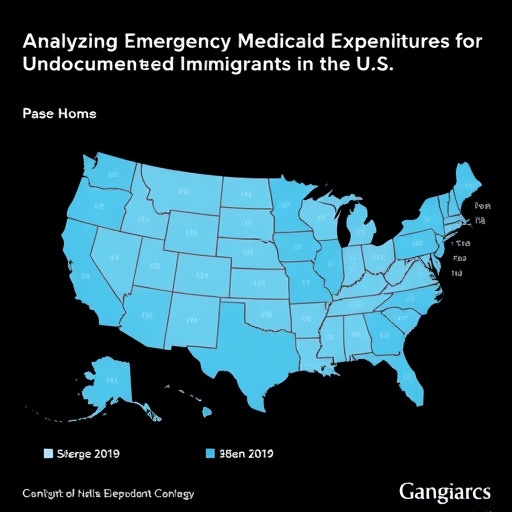In a comprehensive nationwide study recently published in JAMA, researchers have shed new light on the often-debated fiscal impact of emergency Medicaid expenditures across the United States. This meticulous analysis dissects Medicaid spending with a particular focus on emergency Medicaid services, revealing that such expenditures account for a surprisingly small fraction of total Medicaid costs nationwide. Despite the prevailing political discourse that suggests emergency Medicaid imposes a significant financial strain on public healthcare budgets, the findings challenge this assumption, emphasizing a more nuanced understanding of the fiscal dynamics involved.
The study highlights that states with larger populations of undocumented immigrants do indeed spend substantially more per capita on emergency Medicaid—approximately fifteen times more than states with smaller undocumented communities. However, even in these states, emergency Medicaid expenditures remain below 1% of total Medicaid spending. This finding importantly reframes the narrative often used to justify cuts in emergency healthcare funding by illustrating the minimal relative financial burden such expenses represent within the broader Medicaid budget.
An in-depth exploration of Medicaid’s fiscal structure reveals that emergency care is a critical component of healthcare access, especially for vulnerable populations who are otherwise excluded from comprehensive Medicaid coverage due to immigration status. The study’s quantitative approach underscores the essential role emergency Medicaid plays as a safety net, preventing catastrophic health outcomes that would translate into even higher costs for healthcare systems if left unaddressed.
Moreover, the researchers emphasize the disproportionate consequences policy changes would have on states with large undocumented populations. By examining per capita expenditure patterns, the study articulates that sweeping cuts to emergency Medicaid would not yield meaningful savings but rather exacerbate health disparities and financial hardships in these communities. This insight signals a need for policymakers to carefully consider the equity implications of proposed funding reductions.
Technically, the study applies rigorous econometric analyses and cross-state comparisons to parse Medicaid spending data, incorporating demographic variables to adjust for undocumented immigrant population density. The methodological framework ensures robust control for confounding factors, enabling clear attribution of spending differences to population composition rather than extraneous economic or systemic variables.
This research further contributes to the discourse on fiscal policy by challenging mythologies that equate immigrant status with disproportionate healthcare costs. It offers empirical evidence that such assumptions are unfounded, particularly within the context of Medicaid’s emergency services. The comprehensive dataset used spans multiple fiscal years, allowing the authors to assess temporal trends and the consistency of their findings over time.
The investigators also probe the healthcare utilization patterns underpinning emergency Medicaid claims, revealing that despite increased per capita spending in some states, the absolute dollar amounts are comparatively modest. This suggests that emergency Medicaid serves primarily as a crucial but restrained safety net rather than a driver of uncontrollable healthcare expenditure growth.
One technical aspect of the study includes its granular approach to demographic categorization, characterized by sophisticated adjustments for state-level variables such as immigration enforcement policies, healthcare infrastructure, and economic conditions. This stratified analysis enhances the precision of expenditure estimates, offering stakeholders a reliable picture upon which to base policy decisions.
From a policy perspective, the study calls into question the efficacy of targeting emergency Medicaid for budget cuts. The marginal fiscal returns from such measures do not compensate for the potential human and economic costs that could arise from reduced access to emergency care. Policymakers are therefore urged to explore alternative avenues for managing Medicaid expenditures that do not undermine essential healthcare protections.
This investigation also aligns with broader health economics literature emphasizing the cost-effectiveness of emergency care as a preventive measure against more expensive, long-term health complications. By investing in emergency services, states can mitigate downstream costs associated with untreated chronic conditions and avoidable hospitalizations.
Additionally, the article underscores the importance of framing Medicaid reform debates within empirical evidence rather than ideological stances. The researchers advocate for an informed dialogue based on data that comprehensively assess costs and benefits, ensuring equitable healthcare access while maintaining fiscal responsibility.
The study’s findings highlight the interconnectedness of social determinants of health, immigration policy, and public finance. It encourages further interdisciplinary research to explore these intersections with greater depth, ultimately fostering policies that reconcile economic efficiency with social justice imperatives.
In conclusion, this JAMA study represents a pivotal contribution to the understanding of Medicaid’s financial landscape, particularly in relation to emergency services and undocumented immigrant populations. It dismantles common misconceptions about the burden emergency Medicaid places on state budgets and illustrates the critical role this program plays in preserving both public health and fiscal prudence.
Subject of Research: Emergency Medicaid expenditures and their fiscal impact across U.S. states, with a focus on populations of undocumented immigrants.
Article Title: Not provided in the source content.
News Publication Date: Not specified.
Web References: Not provided.
References: (doi:10.1001/jama.2025.18709)
Image Credits: Not provided.
Keywords: Health insurance, Emergency medicine, United States population, Fiscal policy




